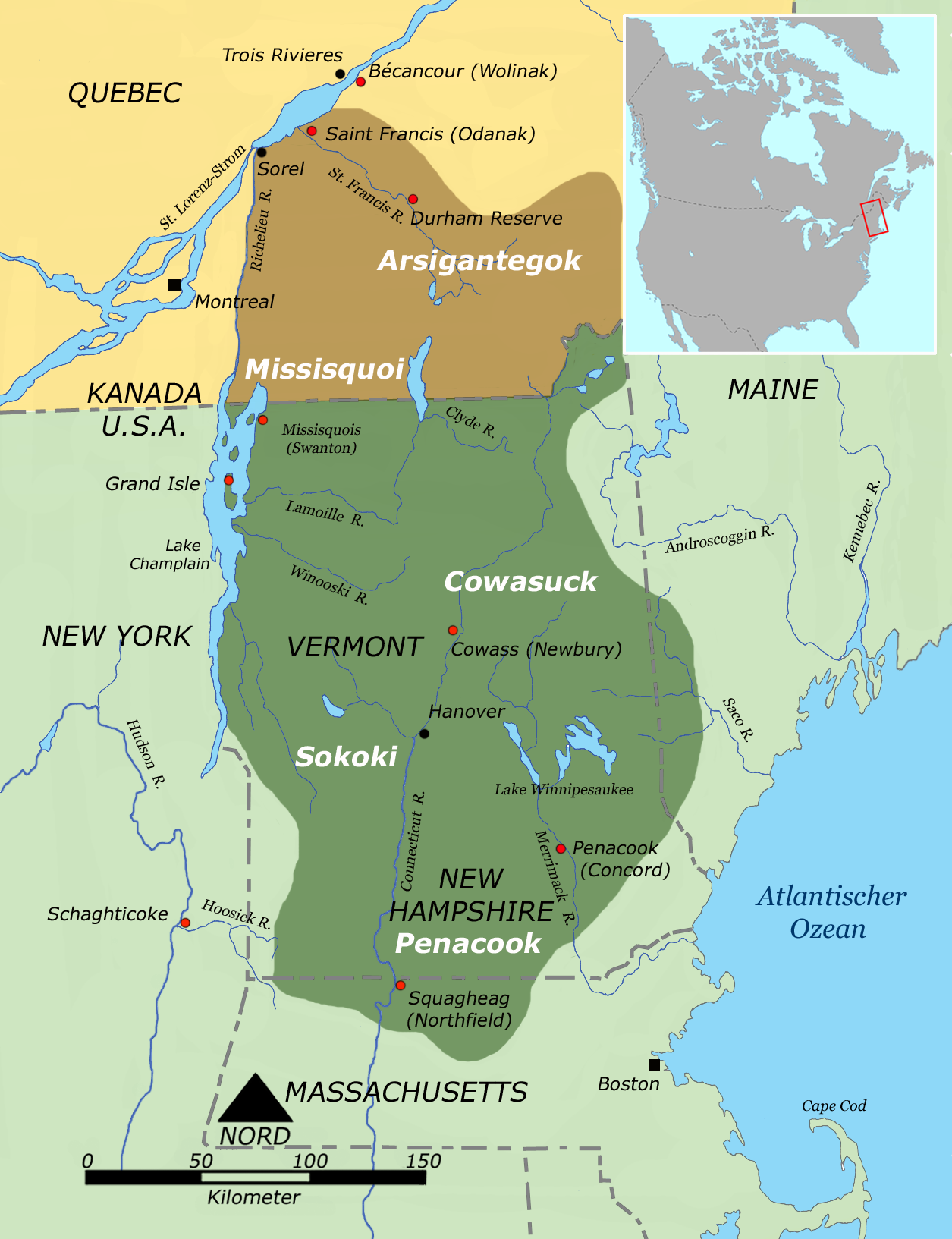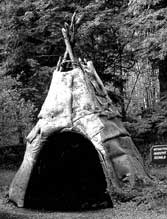|
Sokoki
The Missiquoi (or the Missisquoi or the Sokoki) were a historic band of Abenaki Indigenous peoples from present-day southern Quebec and formerly northern Vermont. This Algonquian-speaking group lived along the eastern shore of Lake Champlain at the time of the European incursion. Today, they are part of the Conseil des Abénakis d'Odanak, a First Nation in Quebec. Missiquoi is also the name of a 17th-century Abenaki village in northern Vermont, for which the sub-tribe was named. Name The name ''Missisquoi'' comes from ''mazipskoiak'' meaning "flint people," which comes from ''mazipskoik'' or "at the flint," meaning a chert quarry near what is now Swanton, Vermont. It's also spelled ''Missiassik'' or ''Masipskoik'' a word that means "where there are many big rocks or boulder" in Abenaki. History Prior to European contact, some Western Abenaki founded villages at the mouth of the Missisquoi River. By the 17th century, Western Abenaki from across Lake Champlain consolidate ... [...More Info...] [...Related Items...] OR: [Wikipedia] [Google] [Baidu] |
Western Abenaki Language
Abenaki (Eastern: ', Western: ), also known as Wôbanakiak, is an endangered Eastern Algonquian language of Quebec and the northern states of New England. The language has Eastern and Western forms which differ in vocabulary and phonology and are sometimes considered distinct languages. Western Abenaki was spoken in New Hampshire, Vermont, north-western Massachusetts, and southern Quebec. Odanak, Quebec is a First Nations reserve located near the Saint-François River—these peoples were referred to as Saint Francis Indians by English writers after the 1700s. The few remaining speakers of Western Abenaki live predominantly in Odanak and the last fully fluent speaker, Cécile (Wawanolett) Joubert died in 2006. A revitalization effort was started in Odanak in 1994; however, as of 2004 younger generations are not learning the language and the remaining speakers are elderly, making Western Abenaki nearly extinct. Eastern Abenaki languages are spoken by several peoples, incl ... [...More Info...] [...Related Items...] OR: [Wikipedia] [Google] [Baidu] |
Conseil Des Abénakis D'Odanak
Odanak is an Abenaki First Nations reserve in the Central Quebec region, Quebec, Canada. The mostly First Nations population as of the 2021 Canadian census was 481. The territory is located near the mouth of the Saint-François River at its confluence with the St. Lawrence River. It is partly within the limits of Pierreville and across the river from Saint-François-du-Lac. ''Odanak'' is an Abenaki word meaning "in the village". History Beginning about 1000 CE, Iroquoian-speaking people settled along the St. Lawrence River, where they practiced agriculture along with hunting and fishing. Archeological surveys have revealed that by 1300, they built fortified villages similar to those seen and described by French explorer Jacques Cartier in the mid-16th century, when he visited Hochelaga and Stadacona. However, by 1600, the villages and people were gone. Since the 1950s, historians and anthropologists have used archeological and linguistic evidence to develop a consensus that ... [...More Info...] [...Related Items...] OR: [Wikipedia] [Google] [Baidu] |
Western Abenaki
The Abenaki (Abenaki: ''Wαpánahki'') are Indigenous people of the Northeastern Woodlands of Canada and the United States. They are an Algonquian-speaking people and part of the Wabanaki Confederacy. The Eastern Abenaki language was predominantly spoken in Maine, while the Western Abenaki language was spoken in Quebec, Vermont, and New Hampshire. While Abenaki peoples have shared cultural traits, they did not historically have a centralized government. They came together as a post-contact community after their original tribes were decimated by colonization, disease, and warfare. Names The word ''Abenaki'' and its syncope, ''Abnaki,'' are both derived from ''Wabanaki'', or ''Wôbanakiak,'' meaning "People of the Dawn Land" in the Abenaki language. While the two terms are often confused, the Abenaki are one of several tribes in the Wabanaki Confederacy. Alternate spellings include: ''Abnaki'', ''Abinaki'', ''Alnôbak'', ''Abanakee'', ''Abanaki'', ''Abanaqui'', ''Abanaquois ... [...More Info...] [...Related Items...] OR: [Wikipedia] [Google] [Baidu] |
Odanak
Odanak is an Abenaki First Nations reserve in the Central Quebec region, Quebec, Canada. The mostly First Nations population as of the 2021 Canadian census was 481. The territory is located near the mouth of the Saint-François River at its confluence with the St. Lawrence River. It is partly within the limits of Pierreville and across the river from Saint-François-du-Lac. ''Odanak'' is an Abenaki word meaning "in the village". History Beginning about 1000 CE, Iroquoian-speaking people settled along the St. Lawrence River, where they practiced agriculture along with hunting and fishing. Archeological surveys have revealed that by 1300, they built fortified villages similar to those seen and described by French explorer Jacques Cartier in the mid-16th century, when he visited Hochelaga and Stadacona. However, by 1600, the villages and people were gone. Since the 1950s, historians and anthropologists have used archeological and linguistic evidence to develop a consensus ... [...More Info...] [...Related Items...] OR: [Wikipedia] [Google] [Baidu] |
Abenaki
The Abenaki ( Abenaki: ''Wαpánahki'') are Indigenous people of the Northeastern Woodlands of Canada and the United States. They are an Algonquian-speaking people and part of the Wabanaki Confederacy. The Eastern Abenaki language was predominantly spoken in Maine, while the Western Abenaki language was spoken in Quebec, Vermont, and New Hampshire. While Abenaki peoples have shared cultural traits, they did not historically have a centralized government. They came together as a post-contact community after their original tribes were decimated by colonization, disease, and warfare. Names The word ''Abenaki'' and its syncope, ''Abnaki,'' are both derived from ''Wabanaki'', or ''Wôbanakiak,'' meaning "People of the Dawn Land" in the Abenaki language. While the two terms are often confused, the Abenaki are one of several tribes in the Wabanaki Confederacy. Alternate spellings include: ''Abnaki'', ''Abinaki'', ''Alnôbak'', ''Abanakee'', ''Abanaki'', ''Abanaqui'', ''Abana ... [...More Info...] [...Related Items...] OR: [Wikipedia] [Google] [Baidu] |
Connecticut River
The Connecticut River is the longest river in the New England region of the United States, flowing roughly southward for through four states. It rises 300 yards (270 m) south of the U.S. border with Quebec, Canada, and discharges into Long Island Sound between Old Saybrook, Connecticut, Old Saybrook and Old Lyme, Connecticut. Its watershed encompasses , covering parts of five U.S. states and one Canadian province, via 148 tributaries, 38 of which are major rivers. It produces 70% of Long Island Sound's fresh water, discharging at per second. The Connecticut River Valley is home to some of the northeastern United States' most productive farmland, as well as the Hartford–Springfield, Hartford–Springfield Knowledge Corridor, a metropolitan region of approximately two million people surrounding Springfield, Massachusetts, and Hartford, Connecticut. History The word "Connecticut" is a Corruption (linguistics), corruption of the Mohegan word ''quinetucket'' and Nipmuc word ''kw ... [...More Info...] [...Related Items...] OR: [Wikipedia] [Google] [Baidu] |
State-recognized
State-recognized tribes in the United States are Native American tribes or heritage groups that do not meet the criteria for federally recognized Indian tribes but have been recognized by state government through laws, governor's executive orders, or state commissions legally granted the power to recognize tribes for varying purposes. State recognition does not dictate whether or not they are recognized as Native American tribes by continually existing tribal nations. Individual states confer state-recognition "for their various internal state government purposes." Members of a state-recognized tribe are still subject to state law and government, and the tribe does not have sovereign control over its affairs. State recognition confers few benefits under federal law. It is not the same as federal recognition, which is the federal government's acknowledgment of a tribe as a dependent sovereign nation. Some states have provided laws related to state recognition that provide some pr ... [...More Info...] [...Related Items...] OR: [Wikipedia] [Google] [Baidu] |
Quebec
Quebec is Canada's List of Canadian provinces and territories by area, largest province by area. Located in Central Canada, the province shares borders with the provinces of Ontario to the west, Newfoundland and Labrador to the northeast, New Brunswick to the southeast and a coastal border with the territory of Nunavut. In the south, it shares a border with the United States. Between 1534 and 1763, what is now Quebec was the List of French possessions and colonies, French colony of ''Canada (New France), Canada'' and was the most developed colony in New France. Following the Seven Years' War, ''Canada'' became a Territorial evolution of the British Empire#List of territories that were once a part of the British Empire, British colony, first as the Province of Quebec (1763–1791), Province of Quebec (1763–1791), then Lower Canada (1791–1841), and lastly part of the Province of Canada (1841–1867) as a result of the Lower Canada Rebellion. It was Canadian Confederation, ... [...More Info...] [...Related Items...] OR: [Wikipedia] [Google] [Baidu] |
Quebec, Canada
Quebec is Canada's largest province by area. Located in Central Canada, the province shares borders with the provinces of Ontario to the west, Newfoundland and Labrador to the northeast, New Brunswick to the southeast and a coastal border with the territory of Nunavut. In the south, it shares a border with the United States. Between 1534 and 1763, what is now Quebec was the French colony of ''Canada'' and was the most developed colony in New France. Following the Seven Years' War, ''Canada'' became a British colony, first as the Province of Quebec (1763–1791), then Lower Canada (1791–1841), and lastly part of the Province of Canada (1841–1867) as a result of the Lower Canada Rebellion. It was confederated with Ontario, Nova Scotia, and New Brunswick in 1867. Until the early 1960s, the Catholic Church played a large role in the social and cultural institutions in Quebec. However, the Quiet Revolution of the 1960s to 1980s increased the role of the Government of Qu ... [...More Info...] [...Related Items...] OR: [Wikipedia] [Google] [Baidu] |
American Revolutionary War
The American Revolutionary War (April 19, 1775 – September 3, 1783), also known as the Revolutionary War or American War of Independence, was the armed conflict that comprised the final eight years of the broader American Revolution, in which American Patriot (American Revolution), Patriot forces organized as the Continental Army and commanded by George Washington defeated the British Army during the American Revolutionary War, British Army. The conflict was fought in North America, the Caribbean, and the Atlantic Ocean. The war's outcome seemed uncertain for most of the war. However, Washington and the Continental Army's decisive victory in the Siege of Yorktown in 1781 led King George III and the Kingdom of Great Britain to negotiate an end to the war in the Treaty of Paris (1783), Treaty of Paris two years later, in 1783, in which the British monarchy acknowledged the independence of the Thirteen Colonies, leading to the establishment of the United States as an independent and ... [...More Info...] [...Related Items...] OR: [Wikipedia] [Google] [Baidu] |
Native American Tribe
In the United States, an American Indian tribe, Native American tribe, Alaska Native village, Indigenous tribe, or Tribal nation may be any current or historical Tribe (Native American)#Other uses, tribe, band, or nation of Native Americans in the United States. Modern forms of these entities are often associated with land or territory of an Indian reservation. "Federally recognized Indian tribes, Federally recognized Indian tribe" is a legal term in United States law with a specific meaning. A Native American tribe recognized by the United States government possesses tribal sovereignty, a "domestic dependent, sovereign nation" status with the U.S. federal government that is similar to that of a state in some situations, and that of a nation in others, holding a government-to-government relationship with the federal government of the United States. Legal definition in the United States The term "tribe" is defined in the United States for some Government of the United States, ... [...More Info...] [...Related Items...] OR: [Wikipedia] [Google] [Baidu] |








